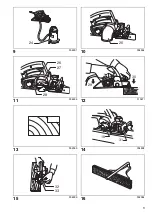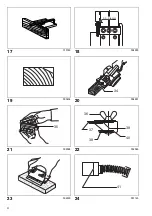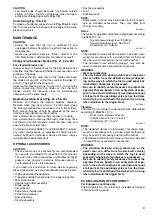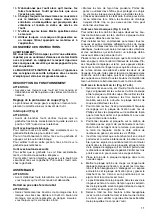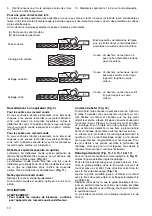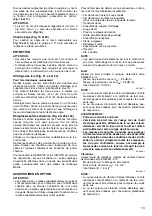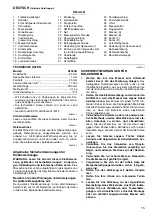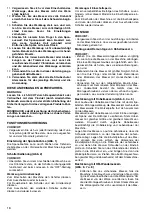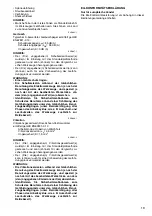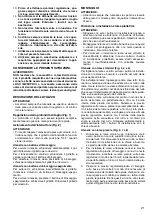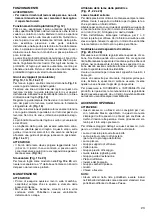
9
CAUTION:
• The blade edge should be made to protrude outside
slightly (0.3 mm – 0.6 mm). Otherwise, nicks and gen-
erally poor shiplapping results.
(Fig. 18)
Chamfering (Fig. 19 & 20)
To make a chamfering cut as shown in
Fig. 19 & 20
, align
the “V” groove in the front base with the edge of the work-
piece and plane it.
MAINTENANCE
CAUTION:
• Always be sure that the tool is switched off and
unplugged before attempting to perform inspection or
maintenance.
• Never use gasoline, benzine, thinner, alcohol or the
like. Discoloration, deformation or cracks may result.
Sharpening the planer blades (Fig. 21, 22 & 23)
For standard blades only
Always keep your blades sharp for the best performance
possible. Use the sharpening holder to remove nicks and
produce a fine edge.
First, loosen the two wing nuts on the holder and insert
the blades (A) and (B), so that they contact the sides (C)
and (D). Then tighten the wing nuts.
Immerse the dressing stone in water for 2 or 3 minutes
before sharpening. Hold the holder so that the both
blades contact the dressing stone for simultaneous
sharpening at the same angle.
Replacing carbon brush (Fig. 24, 25 & 26)
Remove and check the carbon brushes regularly.
Replace when they wear down to the limit mark. Keep
the carbon brushes clean and free to slip in the holders.
Both carbon brushes should be replaced at the same
time. Use only identical carbon brushes.
Use a screwdriver to remove the chip cover or nozzle.
Use a screwdriver to remove the brush holder caps. Take
out the worn carbon brushes, insert the new ones and
secure the brush holder caps.
To maintain product SAFETY and RELIABILITY, repairs,
any other maintenance or adjustment should be per-
formed by Makita Authorized Service Centers, always
using Makita replacement parts.
OPTIONAL ACCESSORIES
CAUTION:
• These accessories or attachments are recommended
for use with your Makita tool specified in this manual.
The use of any other accessories or attachments might
present a risk of injury to persons. Only use accessory
or attachment for its stated purpose.
If you need any assistance for more details regarding
these accessories, ask your local Makita Service Center.
• High-speed steel Planer blade
• Tungsten-carbide Planer blade (For longer blade life)
• Mini planer blade
• Sharpening holder assembly
• Blade gauge
• Set plate set
• Edge fence (Guide rule)
• Extension guide set
• Dressing stone
• Nozzle assembly
• Dust bag assembly
• Joint
• Socket wrench
NOTE:
• Some items in the list may be included in the tool pack-
age as standard accessories. They may differ from
country to country.
ENG905-1
Noise
The typical A-weighted noise level determined according
to EN62841-2-14:
Sound pressure level (L
pA
): 85 dB (A)
Sound power level (L
WA
): 96 dB (A)
Uncertainty (K): 3 dB (A)
ENG907-1
NOTE:
• The declared noise emission value(s) has been mea-
sured in accordance with a standard test method and
may be used for comparing one tool with another.
• The declared noise emission value(s) may also be
used in a preliminary assessment of exposure.
WARNING:
• Wear ear protection.
• The noise emission during actual use of the power
tool can differ from the declared value(s) depend-
ing on the ways in which the tool is used especially
what kind of workpiece is processed.
• Be sure to identify safety measures to protect the
operator that are based on an estimation of expo-
sure in the actual conditions of use (taking account
of all parts of the operating cycle such as the times
when the tool is switched off and when it is running
idle in addition to the trigger time).
ENG900-1
Vibration
The vibration total value (tri-axial vector sum) determined
according to EN62841-2-14:
Work mode: planing softwood
Vibration emission (
a
h
): 4.5 m/s
2
Uncertainty (K): 1.5 m/s
2
ENG901-2
NOTE:
• The declared vibration total value(s) has been mea-
sured in accordance with a standard test method and
may be used for comparing one tool with another.
• The declared vibration total value(s) may also be used
in a preliminary assessment of exposure.
WARNING:
• The vibration emission during actual use of the
power tool can differ from the declared value(s)
depending on the ways in which the tool is used
especially what kind of workpiece is processed.
• Be sure to identify safety measures to protect the
operator that are based on an estimation of expo-
sure in the actual conditions of use (taking account
of all parts of the operating cycle such as the times
when the tool is switched off and when it is running
idle in addition to the trigger time).
EC DECLARATION OF CONFORMITY
For European countries only
The EC declaration of conformity is included as Annex A
to this instruction manual.
Summary of Contents for N1923B
Page 5: ...5 25 26 44 43 42 43 004903 004905 ...
Page 61: ...61 ...
Page 62: ...62 ...
Page 63: ...63 ...



